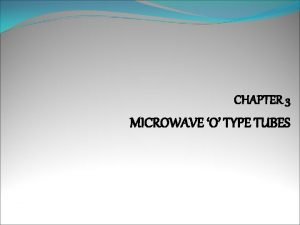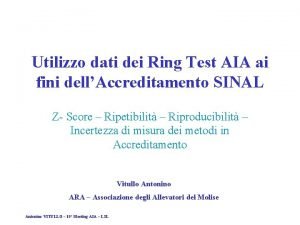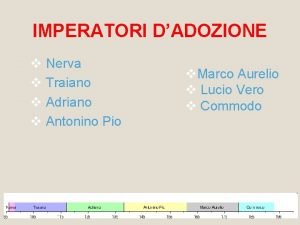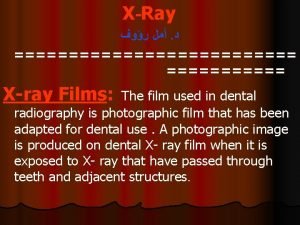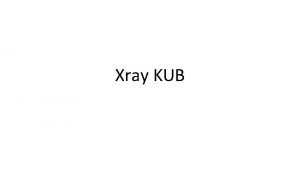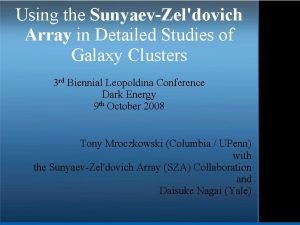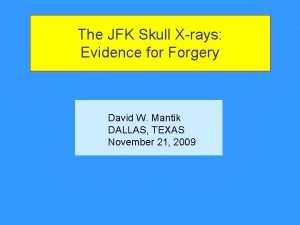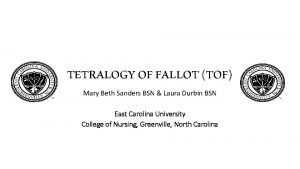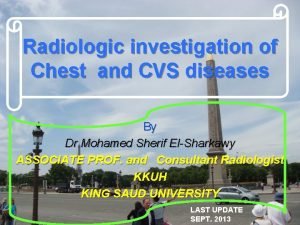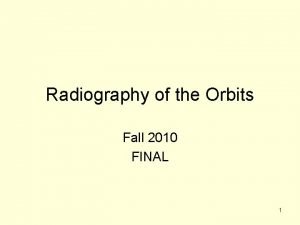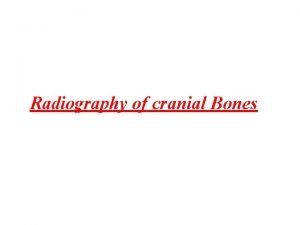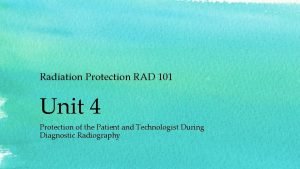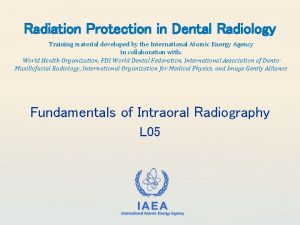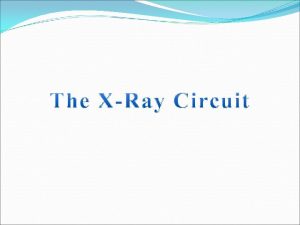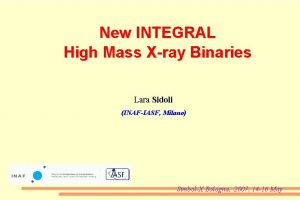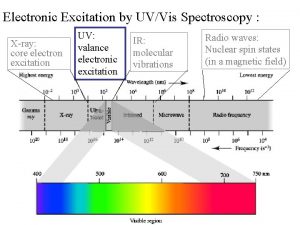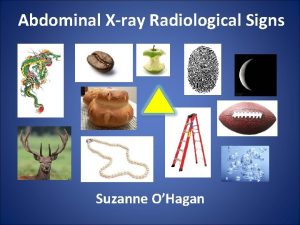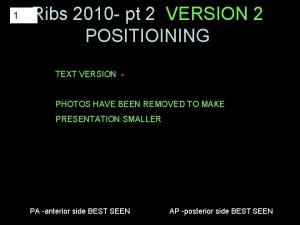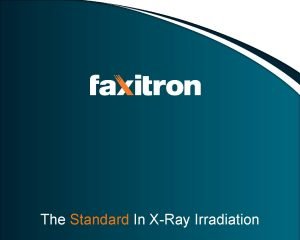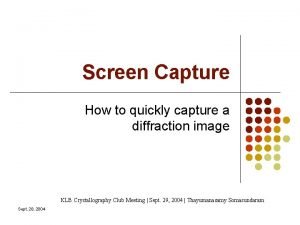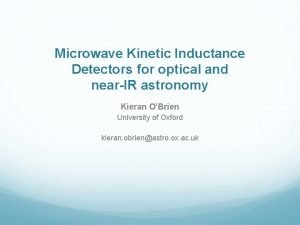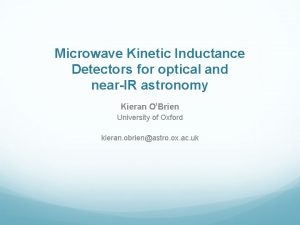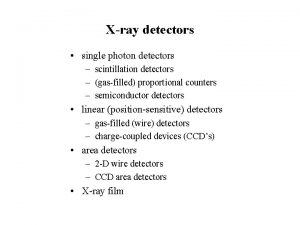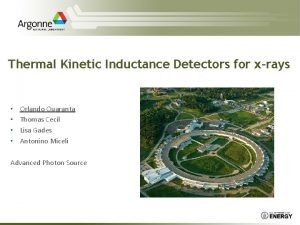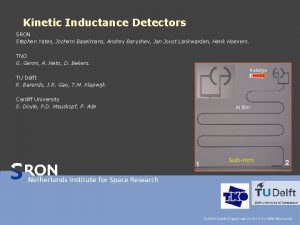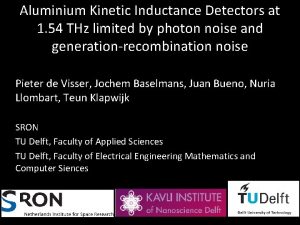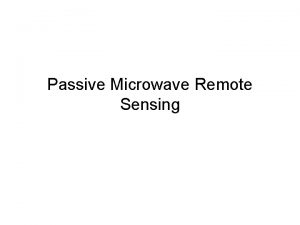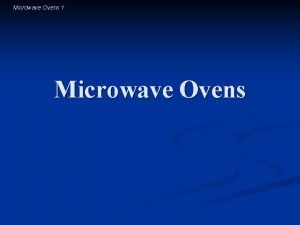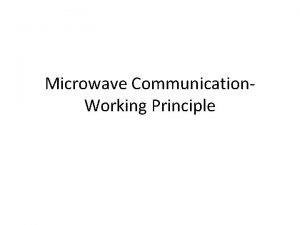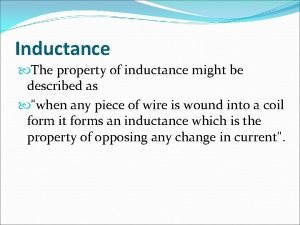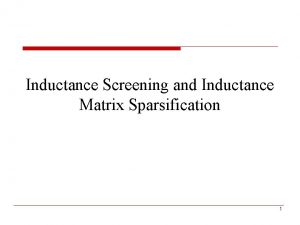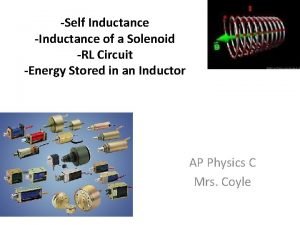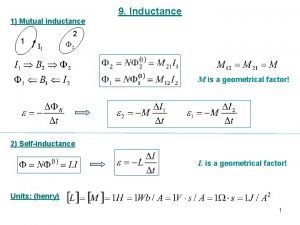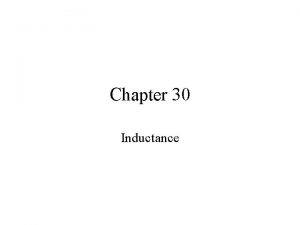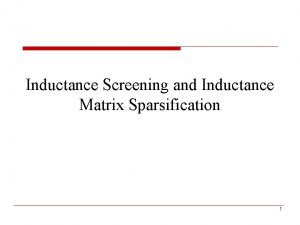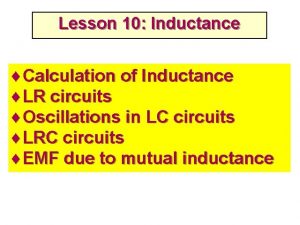Microwave Kinetic Inductance Detectors for Xray Science Antonino











































- Slides: 43

Microwave Kinetic Inductance Detectors for X-ray Science Antonino Miceli FNAL Research Techniques Seminar April 24, 2012

Outline § Why Superconducting Detectors? – Detector Requirements – Applications § Overview of MKIDs § MKID activities at Argonne § MKID resonator readout

Acknowledgements § § Tom Cecil (XSD Staff) Orlando Quaranta (Post-doc) Lisa Gades (XSD Staff) Outside Collaborators: – Professor Ben Mazin (UCSB) – MSD/UChicago TES Team (Novosad et al) – CNM Cleanroom Staff

Superconductors Detectors for X-ray Detector R&D § Energy dispersive semiconductor detectors have almost reached their theoretical limits – e. g. , Silicon Drift Diodes have energy resolution ~ 150 e. V at 6 ke. V § Limited R&D on spectroscopic detectors – Only effort is Silicon array detector of Peter Siddons (BNL) and Chris Ryan (Australia) • Using silicon arrays to achieve large collection solid angles for fluorescence experiments. § Leverages local facilities and existing projects. – ANL’s Center for Nanoscale Materials for device fabrication – Many groups with thin film deposition experience – Superconducting Transition Edge Sensors for UChicago’s SPTpol • ANL’s Material Science Division

Detector Requirements § Solid angle coverage – Pixel area and sample-detector distance § Count-rate – Need lots of pixels (i. e. multiplexing) if you going to deal with superconducting detectors, which tend to be slow § Peak-to-background ratio – Maximize charge collection – Minimum of 1000: 1 – Limits overall sensitivity § Energy resolution – Depends on applications (1 -50 e. V at 6 ke. V)

Applications for superconducting x-ray detectors? § X-ray Inelastic Scattering – Access wide range of excitations. – Superconducting detectors allows broadband efficient measurement compared to crystal analyzers (i. e. , wavelength dispersive spectrographs). § X-ray Fluorescence – Fluorescence line overlap in complex biological samples – Fluorescence Tomography • Needs pixelated energy-dispersive detectors § White-Beam Diffraction (ED-XRD) – Versus angle-dispersive diffraction • Using monochromatic incoming beam and area detector – Complex sample environments (e. g. , high-pressure cells)

Competing with x-ray spectrographs (like astronomers…)

Quasiparticle detectors § Use small Superconducting Energy Gap § Break Cooper Pairs § Use Cooper Pairs as detection mechanism (like electron hole pairs in a semiconductor) Semiconductor Energy Gap: ≈ 1 e. V Superconductor Energy Gap: ≈ 1 me. V Cooper Pair How to measure change in quasiparticle number?

Microwave Kinetic Inductance Detectors § Quasiparticle generated by x-ray causes an inductance increase (i. e. , “kinetic inductance”) – Measure inductance change in a LC resonating circuit Observables…. DLs Multiplexing: Lithographically vary geometric inductance/resonant frequency… DRs Ø 1024 pixels demonstrated in 2011 Ø People are contemplating 10 k pixels now • Limited by room temperature electronics

What has been shown already for x-rays? 62 e. V Mazin et al 2006 Material Atomic Number Z Transition Temperature Theoretical Energy Resolution at 6 ke. V Lead 82 7. 2 Kelvin Tantalum Tin Indium Rhenium 73 50 49 75 4. 5 Kelvin 3. 7 Kelvin 3. 4 Kelvin 1. 7 Kelvin 3. 53 e. V 2. 79 e. V 2. 53 e. V 2. 43 e. V 1. 72 e. V 1. 86 1. 79 2. 60 2. 77 1. 31 Molybdenum 42 . 92 Kelvin 1. 26 e. V 2. 94 mm Osmium 76 . 66 Kelvin 1. 07 e. V 1. 18 mm Attenuation Length at 6 ke. V mm mm mm

MKIDs @ Argonne for synchrotrons § The goal is moderate energy resolution (< 20 e. V) with good count rate capabilities (> 200 kcps) (i. e. , ~200 -500 pixels) § Leverages Argonne’s micro/nano-fab facilities (CNM) and superconductivity expertise (MSD); Astronomical TES bolometer program(MSD & UChicago). § Three Main Aspects: 1. Device Fabrication Ø Fabrication is completely in-house Ø Relatively “simple”… patterning of metal (deposition, photolithography, etching) Ø Film quality is very important! Ø Initially aim a simple device, then progress to more complex designs (e. g. , membranesuspended) Ø Dedicated deposition system on order. 2. Cryogenics and Device Characterization Ø We are mostly limited by how fast we can test devices. 3. Readout electronics Ø Initially the analog readout for characterization. Ø Digital FPGA-based array readout in the near future.

Anatomy of an MKID – Our work 1 pixel 15 pixels (one design) Inductor/Absorber Capacitor 1 micron WSi 2 (XSD) 2 mm Ø First x-ray pulses at APS in January 2012! Ø Fe-55 and Cd-109

Detector Testing Cryostat § Cryostat Ø Cryogen Free ADR Ø T = 100 m. K for 2 days Ø 3 -4 hour recycle time § Microwave Electronics § § Vector Network Analyzer IQ mixing § Control & Data Analysis Software Microwave Electronics Be window (x-ray transparent)

Inside the cryostat… Attenuator 60 K stage m-metal shield LNA 4 K stage 0. 5 K stage Stainless Steel coax Nb. Ti (superconducting) coax Sample box @ 60 m. K

§ Measure the transmission through the device (S 21) – Wide range of frequency: 0. 3 - 20 GHz – Easily identify resonators: • Resonance frequencies, Quality Factors (Qr, Qc, Qi) – Cannot measure pulses nor noise VNA

§ IQ mixing (Pulses and Noise) – Homodyne mixing – Demodulate to 0 Hz (DC) and monitor for changes in Re(S 21) and Im(S 21) (i. e. , I & Q) – Amplitude = sqrt(I 2 + Q 2) – Phase= arctan(Q/I) Signal Generators IQ Mixer Variable attenuator

Imag (S 21) IQ Fitting and parameter extraction Real (S 21) Frequency (GHz)

I &Q Pulses Time (ms) Phase Amplitude § Pulse fitting – Decay Time -> Quasiparticle life time – Phase pulse height -> Energy of the incident photon – The signal in phase is larger than amplitude

Tungsten Silicide MKIDs § We have been searching for dense materials for xrays. § WSix is a material with low Tc, high kinetic inductance fraction and good quality factors. – Similar to Titanium Nitride – Maybe also be interesting for optical MKIDs. ar. Xiv: 1203. 5064 v 1

Optical MKIDs (Mazin et al) -- Spectrophotometry R=E/ΔE=16 at 254 nm Ø Limited by LNA/power handling/Q Mazin et al. , Optics Express 2012

A readout for large arrays of Microwave Kinetic Inductance Detectors (Mc. Hugh, Mazin et al, ar. Xiv: 1203. 5861 v 1) How to readout 1024 MKIDs….

Another technology – Transition Edge Sensors § TES have the best energy resolution (not Fano limited) § However, TES require relatively complex cryogenic electronics which makes multiplexing difficult. – Limited to 200 pixels right now. § Also, larger pixel means slower response….

TES are evolving towards MKID/resonator readout § “Microwave SQUIDs” B. Mates et al Ap. L 2008 (NIST) § Eventually would like a wideband, quantum-limited LNA for MKIDs (i. e. , don’t need SQUID anymore) – Josephson parametric amp (J. Gao et al) • ar. Xiv: 1008. 0046 v 1 – Kinetic Inductance parametric amp (P. Day et al) • ar. Xiv: 1201. 2392 v 1 Superconducting microwave resonant circuits for the detection of photons from microwaves through gamma rays, Irwin, K. D. , et al. Microwave Symposium Digest (MTT), 2011 IEEE MTT-S International , vol. , no. , pp. 1 -4, 5 -10 June 2011

Conclusions § Superconducting detector development has started at the APS. – Testing infrastructure (cryo, electronics, analysis software) is complete. – Now focusing on device fabrication and iterating on designs § MKIDs are a path towards high count rates and higher solid angle coverage. – Has the potential to provide a very unique capability (detector/instrument) for the APS. § MKIDs are a relatively young technology and there is room for R&D. § Thank you!

The End

Extra Slides

Comparison of Silicon Drift Diode, MAIA, TES and MKID Area Silicon Drift Diode 40 mm 2 MAIA 1 mm 2 x 384 NIST TES 0. 14 mm 2 per pixel (256+ pixels) MKIDs mm 2 0. 14 per pixel Sensor. Window Distance 5 mm Energy Resolution @ 6 ke. V Max Count rate (per pixel) 250 e. V 250 k. Hz 175 e. V 100 k. Hz P/B ratio 5000: 1 (? ) Energy Range State of maturity < 20 ke. V Commercial ly Available < 20 ke. V Semicommercial ? ? 5 mm 250 e. V 20 k. Hz per pixel 5000: 1 (? ) 1 cm 3 e. V @ 6 ke. V 18 e. V @ 40 ke. V 70 e. V @ 100 ke. V 10 -100 Hz/pixel (256+ pixels) ? ? 300 e. V – 100 ke. V Semicommercial 1 cm 60 e. V (2006) 2 e. V is theoretical limit 4000 Hz/pixel (256+ pixels) ? ? 300 e. V 100 ke. V R&D +

Silicon Drift Diodes § Commercially available – E. g. , Vortex 4 -pixel SDD (4 x 40 mm 2) § Performance of single pixel SDDs (measured) – Mn Ka FWHM ~ 250 e. V (Max Count rate ~ 250 k. Hz per pixel) – Mn Ka FWHM ~ 175 e. V (Max Count rate ~ 100 k. Hz per pixel) § SDD have reached their limits of energy resolution. § Only improvement to be made is more pixels to increase total count rate throughput and solid angle collection. – Thus, the MAIA detector (BNL/Australia)!



• Speed and resolution are inverse proportional. Ø Controllable thermal conductance to bath (“G”) Ø Si. N membrane geometry

Phonon-Coupled MKIDs -- Single Photon Emission CT -SPECT § § § SPECT Imaging (for animals) Patrick La Riviere thinks phonon-coupled MKIDs might be good for this. Also interesting for high-energy x-ray applications Sunil Golwala et al

Current Status of MKID Research at APS II § Exploring various detector configurations – Quasiparticle Trapping Tradition Configuration • 60 e. V resolution and 4000 cps per pixel proven in 2006 • 30 e. V should be “easily” possible – More is understood about noise sources • 2 e. V is theoretical limit at 6 ke. V – Lump-element design (WSix) No charge diffusion High Peak-to-Background Inductor/Absorber Capacitor – Phonon-Coupled Large pixels and thick silicon (or other dielectric material for absorption Resonator Si. N membrane Silicon Absorber (1 mm)

• Pump-probe XAS w/o mono • 3 e. V at 7 ke. V • 80 Hz with 40 pixels (256 possible today) • 80 Hz * 256 = 20 k. Hz (TDM) • 80 Hz * 1000 = 80 k. Hz (CDM) This starts to be very interesting for RIXS/XES/XANES

MKIDs – Readout Scheme Multiplexing is main advantage of MKIDs over STJs and TES Should be able to readout ~4000 pixels

MKID Array readout § Room temperature electronics – Transfer complexity from cryogenic electronics (TES & SQUIDs) to room temperature. – Scalable system § Array size limitation is room temperature electronics (512 is practical today) – Riding on Moore’s Law for room temperature microwave integrated circuits developed for the wireless communications industry. GHz Synthsizer 16 -bit D/A 14 -bit A/D X IQ Mixer X 16 -bit D/A 14 -bit A/D Low Pass Filters FPGAbased IQ demodulat ion (Xilinx SX 95 T RF Engines Channel Core)

Quasiparticle Generation – A Cascade Process Incoming Photon absorbed, ionizing atom and releasing inner-shell electron 1. First Stage: Rapid energy down-conversion (electron-electron interactions secondary ionization and cascade plasmon emission) Ø Ø e. g. 10 ke. V photoelectron down-conversion to a thermal population of electrons and holes at a characteristics energy ~ 1 e. V takes 0. 1 ps (Kozorezov et al ) 1 st stage ends when electron-phonon inelastic scattering rate dominates electron-electron interactions. 2. Second Stage: ~ 1 e. V down-convert to large number of Debye energy phonons Ø Ø Ø Energy of phonon distribution exceeds energy of electron distribution Debye energy of superconductors is larger than SC gap energy Phonons with energy > 2 D will generate quasiparticles. Finally, we have a mixed distribution of quasiparticle and phonons: • Nqp ~ Ephoton/D • But scaled down because large percentage of photon energy stays in the phonon system • For Tantalaum, 60% energy resides in qp system. (Kurakado) (Efficiency h) • Nqp = hhn/D • At 6 ke. V and Ta absorber, D = 0. 67 me. V 5 Million qp!!

Phonon Trapping § Dominant phonon loss mechanism for Ta and Al is through the substrate. – Copper Pair breaking phonons Mean Free path ~ 50 nm § Effective quasiparticle lifetime is lengthened by phonon trapping. – Acoustic match between superconducting film and substrate. Ø Thus thicker films or membrane-suspended absorbers.

Two major classes of Superconducting Detectors § Thermal Detectors (i. e. , Transition Edge Sensors) § Quasiparticle Detectors

Transition-Edge Sensors (TES) 1/e response time = 100 μs - 1 ms Kent Irwin, NIST

Transition-Edge Sensors (TES) Irwin & Ullom, NIST § TES have the best energy resolution (not Fano limited) § However, TES require relatively complex cryogenic electronics which makes multiplexing difficult. – Limited to 200 pixels right now. § Also, larger pixel means slower response….

TES array at NSLS (NIST U 7 A) Commissioned at NSLS this year…. Waiting for results…

Gamma-Ray TES Array (NIST + Los Alamos) § Resolution Ø 25 e. V at 100 ke. V for 1 mm 2 Ø 20 e. V at 40 ke. V for 1 mm 2 Ø 70 e. V at 100 ke. V for 2 mm 2 § Count Rate Ø 10 Hz/pixel (now) Ø 25 Hz/pixel (soon) § Pixels Ø 256 (now) Ø 1024 (soon)
 Difference between o type and m type tubes
Difference between o type and m type tubes Antonino vitullo
Antonino vitullo Intro to hadoop
Intro to hadoop Antonino belnome
Antonino belnome Nerva traiano adriano antonino pio marco aurelio
Nerva traiano adriano antonino pio marco aurelio Antonino nicoletti
Antonino nicoletti Where are feature detectors located
Where are feature detectors located Kinesthesis and vestibular sense
Kinesthesis and vestibular sense Rhmd: evasion-resilient hardware malware detectors
Rhmd: evasion-resilient hardware malware detectors Feature detectors
Feature detectors Frontier detectors for frontier physics
Frontier detectors for frontier physics Yodsawalai chodpathumwan
Yodsawalai chodpathumwan Photo detectors
Photo detectors What is streaming potential
What is streaming potential Vhv voltage detectors
Vhv voltage detectors Photo detectors
Photo detectors Nuclear detectors
Nuclear detectors Detectors used in hplc
Detectors used in hplc Giant wave detectors murmurs universe
Giant wave detectors murmurs universe Wave could hear murmurs across universe
Wave could hear murmurs across universe My favourite subject is music
My favourite subject is music X-ray mastoid towns view
X-ray mastoid towns view Purpose of lead foil sheet in the film packet
Purpose of lead foil sheet in the film packet Plain film kub
Plain film kub Xray xml editor
Xray xml editor Sza xray
Sza xray Jfk skull
Jfk skull Mary beth sanders
Mary beth sanders Rickets diagnosis
Rickets diagnosis Rib anatomy anterior
Rib anatomy anterior Rhese orbit x ray
Rhese orbit x ray Skull with wings
Skull with wings Xray technique chart
Xray technique chart Emulsion peel in radiography
Emulsion peel in radiography What is a falling load generator
What is a falling load generator 't zand
't zand Subject contrast
Subject contrast Uv xray
Uv xray Tetralogy of fallot xray
Tetralogy of fallot xray Lightbulb xray
Lightbulb xray Noi poi doi toi
Noi poi doi toi Rpo ribs
Rpo ribs Xray file cabinet
Xray file cabinet Gimp xray
Gimp xray
